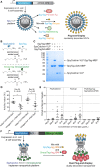New Routes and Opportunities for Modular Construction of Particulate Vaccines: Stick, Click, and Glue
- PMID: 29997617
- PMCID: PMC6028521
- DOI: 10.3389/fimmu.2018.01432
New Routes and Opportunities for Modular Construction of Particulate Vaccines: Stick, Click, and Glue
Abstract
Vaccines based on virus-like particles (VLPs) can induce potent B cell responses. Some non-chimeric VLP-based vaccines are highly successful licensed products (e.g., hepatitis B surface antigen VLPs as a hepatitis B virus vaccine). Chimeric VLPs are designed to take advantage of the VLP framework by decorating the VLP with a different antigen. Despite decades of effort, there have been few licensed chimeric VLP vaccines. Classic approaches to create chimeric VLPs are either genetic fusion or chemical conjugation, using cross-linkers from lysine on the VLP to cysteine on the antigen. We describe the principles that make these classic approaches challenging, in particular for complex, full-length antigens bearing multiple post-translational modifications. We then review recent advances in conjugation approaches for protein-based non-enveloped VLPs or nanoparticles, to overcome such challenges. This includes the use of strong non-covalent assembly methods (stick), unnatural amino acids for bio-orthogonal chemistry (click), and spontaneous isopeptide bond formation by SpyTag/SpyCatcher (glue). Existing applications of these methods are outlined and we critically consider the key practical issues, with particular insight on Tag/Catcher plug-and-display decoration. Finally, we highlight the potential for modular particle decoration to accelerate vaccine generation and prepare for pandemic threats in human and veterinary realms.
Keywords: SpyCatcher; bioconjugation; click chemistry; malaria; synthetic biology; vaccinology; virus-like particle.
Figures




Similar articles
-
Bacterial superglue generates a full-length circumsporozoite protein virus-like particle vaccine capable of inducing high and durable antibody responses.Malar J. 2016 Nov 8;15(1):545. doi: 10.1186/s12936-016-1574-1. Malar J. 2016. PMID: 27825348 Free PMC article.
-
Bacterial superglue enables easy development of efficient virus-like particle based vaccines.J Nanobiotechnology. 2016 Apr 27;14:30. doi: 10.1186/s12951-016-0181-1. J Nanobiotechnology. 2016. PMID: 27117585 Free PMC article.
-
SpyTag/SpyCatcher display of influenza M2e peptide on norovirus-like particle provides stronger immunization than direct genetic fusion.Front Cell Infect Microbiol. 2023 Jun 22;13:1216364. doi: 10.3389/fcimb.2023.1216364. eCollection 2023. Front Cell Infect Microbiol. 2023. PMID: 37424789 Free PMC article.
-
Virus-like Particle Vaccines and Platforms for Vaccine Development.Viruses. 2023 May 2;15(5):1109. doi: 10.3390/v15051109. Viruses. 2023. PMID: 37243195 Free PMC article. Review.
-
Plant-derived virus-like particles as vaccines.Hum Vaccin Immunother. 2013 Jan;9(1):26-49. doi: 10.4161/hv.22218. Epub 2012 Sep 20. Hum Vaccin Immunother. 2013. PMID: 22995837 Free PMC article. Review.
Cited by
-
Bacterial extracellular vesicle applications in cancer immunotherapy.Bioact Mater. 2022 Oct 31;22:551-566. doi: 10.1016/j.bioactmat.2022.10.024. eCollection 2023 Apr. Bioact Mater. 2022. PMID: 36382022 Free PMC article.
-
Protein-based antigen presentation platforms for nanoparticle vaccines.NPJ Vaccines. 2021 May 13;6(1):70. doi: 10.1038/s41541-021-00330-7. NPJ Vaccines. 2021. PMID: 33986287 Free PMC article. Review.
-
Phage-like particle vaccines are highly immunogenic and protect against pathogenic coronavirus infection and disease.NPJ Vaccines. 2022 May 26;7(1):57. doi: 10.1038/s41541-022-00481-1. NPJ Vaccines. 2022. PMID: 35618725 Free PMC article.
-
Catching a SPY: Using the SpyCatcher-SpyTag and Related Systems for Labeling and Localizing Bacterial Proteins.Int J Mol Sci. 2019 Apr 30;20(9):2129. doi: 10.3390/ijms20092129. Int J Mol Sci. 2019. PMID: 31052154 Free PMC article. Review.
-
Engineering and Bio/Nanotechnological Applications of Virus Particles.Subcell Biochem. 2024;105:823-878. doi: 10.1007/978-3-031-65187-8_22. Subcell Biochem. 2024. PMID: 39738964 Review.
References
Publication types
Grants and funding
LinkOut - more resources
Full Text Sources
Other Literature Sources

